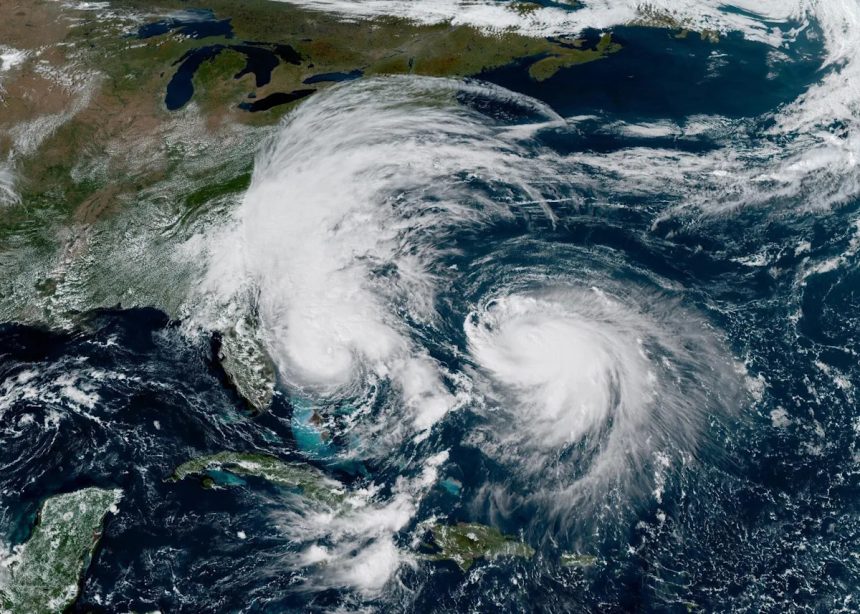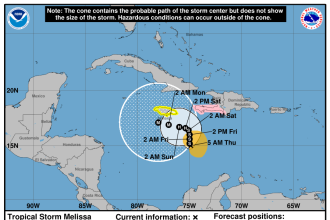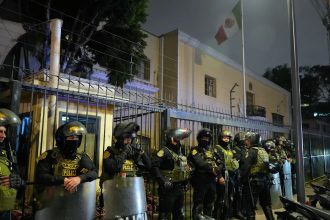Tropical Storm Imelda formed Sunday, Sept. 28, and like hurricanes Erin, Gabrielle and Humberto and tropical storms Andrea, Chantal, Dexter and Fernand before it, the storm seems to be staying to the east of Florida and even curving away.
Not that we’re complaining, but why are storms avoiding the Sunshine State this year, and has it ever happened before?
Early predictions for this year’s Atlantic hurricane season were average or above average, with forecasts of between 13 and 19 tropical storms, from six to 10 hurricanes and three-to-five major hurricanes, depending on which forecasters you looked at. A few services (including the National Oceanic and Atmospheric Administration (NOAA) downgraded their predictions mid-season after 2025 saw the latest-to-form first tropical storm since 2014 and unusually long stretches of inactivity in July and from late August to mid-September.
The season is picking up fast and it’s far from over — and Imelda is expected to swamp much of Florida with rain and thunderstorms with high winds, rough surf, beach erosion and dangerous rip currents on the east coast — but so far this year the Sunshine State has been lucky.
September hurricane season forecast: Savor the break, but trouble is brewing in back half
What’s scaring off the storms?
In the beginning of the season, a North Atlantic high pushed tropical waves coming from Africa farther south than usual and Saharan dust and some obscure weather patterns kept the tropics hostile to further development, forecasters said.
In August, wind shear, dry air and stable atmospheric conditions kept the tropics fairly quiet and even initially prevented Hurricane Gabrielle from fully forming for several days, although once it became a hurricane it intensified into a Category 4 hurricane within a day.
Hurricane Humberto formed well off in the Atlantic and was not considered a threat to Florida.
When Tropical Storm Imelda was developing there was a chance it could threaten the Caribbean islands and parts of Florida, but something called the Fujiwhara effect, where two storms or hurricanes spinning close to each other in the same direction start to revove around their common center, tugged it hard to the east and away from Florida.
Tropical Storm Imelda spaghetti models
Has Florida ever gone a year without a hit from a named storm?
Yes. Lots.
From 2005 through 2015, no hurricane made landfall in Florida, the longest run since we started recording hurricane data in 1851.
We didn’t get away completely scot free. Tropical storms made landfall or impacted the state every year during that time except for 2011 and 2014 and many storms have gotten close without touching but still caused massive damage to the state from wind, rain and flooding..
And, of course, in 2004 Florida was hit with four major hurricanes in a month and a half, and 2016 brought hurricanes Hermine and Matthew.
There have been 34 different years since 1851 without a hurricane landfall or impact on the continental United States, according to NOAA data. Seven of them have happened since 2000: 2000, 2001, 2006, 2009, 2010, 2013 and 2015.
There also have been 18 years without a single tropical storm impact or landfall, although that’s only happened once in the last 25 years, in 2014.
Hurricane Humberto is seen to the west of Tropical Storm Imelda in the Atlantic Monday, Sept. 29, 2025.
Hurricanes, tropical storms impacting Florida in the last 10 years
-
2015: No tropical storms or hurricanes made landfall or significantly impacted Florida
-
2016:
-
May 29: Tropical Storm Bonnie made landfall in South Carolina but one man died in rough surf in Brevard County
-
June 7: Tropical Storm Colin made landfall near Keaton Beach
-
Sept. 2: Hurricane Hermine made landfall near St. Marks as a Category 1, causing an estimated $45.5 million in damages and causing one death
-
Sept. 13: Tropical Storm Julia made landfall in Jensen Beach
-
Oct. 5-7: Hurricane Matthew never made landfall in Florida, but traveled parallel to the coast as a Category 3 hurricane, delivering punishing winds and storm surge that was ultimately responsible for 12 deaths and about $2.75 billion in damage.
-
-
2017:
-
July 30: Tropical Storm Emily made landfall on Longboat Key
-
Sept. 10: Hurricane Irma made landfall in Cudjoe Key before curving around and hitting Marco Island on the west coast and traveling up the state, causing an estimated $50 billion in damages and at least 84 deaths
-
-
2018:
-
May 28: Tropical Storm Alberto made landfall near Laguna Beach
-
Sept. 3: Tropical Storm Gordon made landfall near Flamingo on the southern tip of the Florida peninsula, causing widespread flooding and one death
-
Oct. 10: Hurricane Michael made landfall near Panama City as a Category 5 hurricane, the third-strongest hurricane in terms of pressure to strike the U.S. Michael wiped out 85% of the structures in Panama City alone and was named responsible for approximately 50 deaths, directly and indirectly, and $18.4 billion in damage in Florida
-
-
2019: No tropical storms or hurricane made landfall in Florida. However:
-
Sept. 3-5: Hurricane Dorian did not make landfall but as it traveled up along the coast it knocked out power to thousands, caused coastal flooding and six deaths
-
Sept. 16-18: Hurricane Humberto spun up alongside the Florida coast before abruptly turning northeast, but not before rip currents killed one person and tropical-storm-force winds hit the east coast
-
Oct. 19: Tropical Storm Nestor decreased to extratropical levels before it made landfall near St. Vincent Island, but it brought rainfall and storm surge and and triggered multiple tornadoes
-
-
2020:
-
May 16: Tropical Storm Arthur became a tropical depression off the coast of Melbourne and gradually developed into a tropical storm as it neared North Carolina, but heavy rain, wind and flash floods caused multiple injuries and hospitalizations in Florida and caused an estuiamnted $112,000 in damage
-
May 26: Tropical Storm Bertha started as a trough moving across Florida, developed a surface low near Orlando, and became a tropical storm in the Atlantic, but it brought record rainfall, massive flooding and a tornado to the state
-
August 2-3: Hurricane Isaias dropped down to tropical storm status as it paralled the east coast of Florida but brought gusty winds, heavy rainfall and flooding to the state. Isaias strengthened back into a hurricane before hitting North Carolina.
-
Sept. 12: Hurricane Sally made landfall near Cutler Bay as Tropical Depression Nineteen but it strengthened into a tropical storm over the Everglades
-
Oct. 19-26: Hurricane Epsilon did not make landfall in Florida but it is blamed for one rip current death in Daytona Beach
-
Nov. 9: Hurricane Eta moved across the Florida Keys, looped around in the then-Gulf of Mexico, and dropped to tropical storm status when it hit Cedar Key on Nov. 12
-
-
2021: 3 tropical storms, no hurricanes
-
June 19: Tropical Storm Claudette never made landfall in Florida, but severe thunderstorms and gusty winds caused damage in the Panhandle
-
July 7: Hurricane Elsa struck near Taylor County as a tropical storm, flooding streets and leaving one dead
-
Aug. 16: Tropical Storm Fred made landfall near Cape San Blas, knocking out power for thousands and causing storm surge flooding
-
Sept. 9: Tropical Storm Mindy made landfall on St. Vincent Island and spawned a tornado
-
-
2022:
-
June 4: Tropical Storm Alex was still disorganized when it made landfall between Cape Coral and Naples and became a tropical storm after it exited the state into the Atlantic, but it caused an estimated $383 million in flood damage
-
July 1: Tropical Storm Colin made landfall in South Carolina but brought rain to northeast Florida
-
Sept. 28: Hurricane Ian crossed over the Dry Tortugas and reached Category 5 status in the Gulf before hitting Florida at Cayo Costa Island as a Category 4. Across the state, 149 people died as a direct result, two died from indirect causes and the state suffered an estimated $109.5 billion in damages
-
Nov. 10: Hurricane Nicole made landfall near Vero Beach and brought relatively light rainfall but massice storm surge, causing five indirect deaths
-
-
2023:
-
June 3: Tropical Storm Arlene did not make landfall in Florida but it brought up to 8.82 inches in isolated locations and severethunderstorms across Southern Florida
-
Aug. 30: Hurricane Idalia made landfall near Keaton Beach as a Category 3 hurricane, trearing up structures, flooding the coastal areas and doing an estimated $3.6 billion in damage
-
-
2024:
-
Aug. 5: Hurricane Debby made landfall near Steinhatchee bringing heavy flooding and beach erosion. Three people were killed due to conditions
-
Sept. 27: Hurricane Helene strengthened into a Category 4 hurricane just before it struck Florida in the Big Bend region, the most powerful storm to hit that area since records have been kept. At least 34 people were killed, about 1.3 million lost power, and the storm did an estimated $13.9 billion in damage
-
Oct. 10: Hurricane Milton landed near Siesta Key as a Category 3 hurricane, spawning at least 46 tornadoes (the most in a single day in Florida history), bring hurricane-level winds and rain across the state and causing 42 deaths and more than $34.3 billion in damage
-
Don’t get complacent
None of this is to suggest that Floridians shouldn’t stay on their toes this year. It’s still a long way till the end of the season and it only takes one storm to wreak unimaginable havoc on the state.
Officials regularly encourage Florida residents to prepare for storms before a hurricane is approaching, while shelves are fully stocked and you aren’t battling crowds all rushing to the store at the same time.
On Aug. 1, specific hurricane supplies became permanently tax-free in Florida, ranging from batteries to generators.
Here are some of the basics you should have:
-
Two-week supply of medications
-
A go-bag with essential supplies in case you need to leave quickly
-
Portable cellphone chargers
-
List of emergency phone numbers, including those for family members
-
Copy of your insurance policy
When does hurricane season end?
The Atlantic hurricane season runs from June 1 through Nov. 30.
The peak of the season is Sept. 10, with the most activity happening between mid-August and mid-October, according to the Hurricane Center.
Interactive map: Hurricanes, tropical storms that have passed near your city
Stay informed. Get weather alerts via text
What’s next?
We will update our tropical weather coverage daily.
Download your local site’s app to ensure you’re always connected to the news. And look for our special subscription offers here.
Contributing: Cheryl McCloud, USA TODAY NETWORK-Florida
This article originally appeared on Palm Beach Post: Florida hurricane-free in 2025 so far. Why, is it a first?









